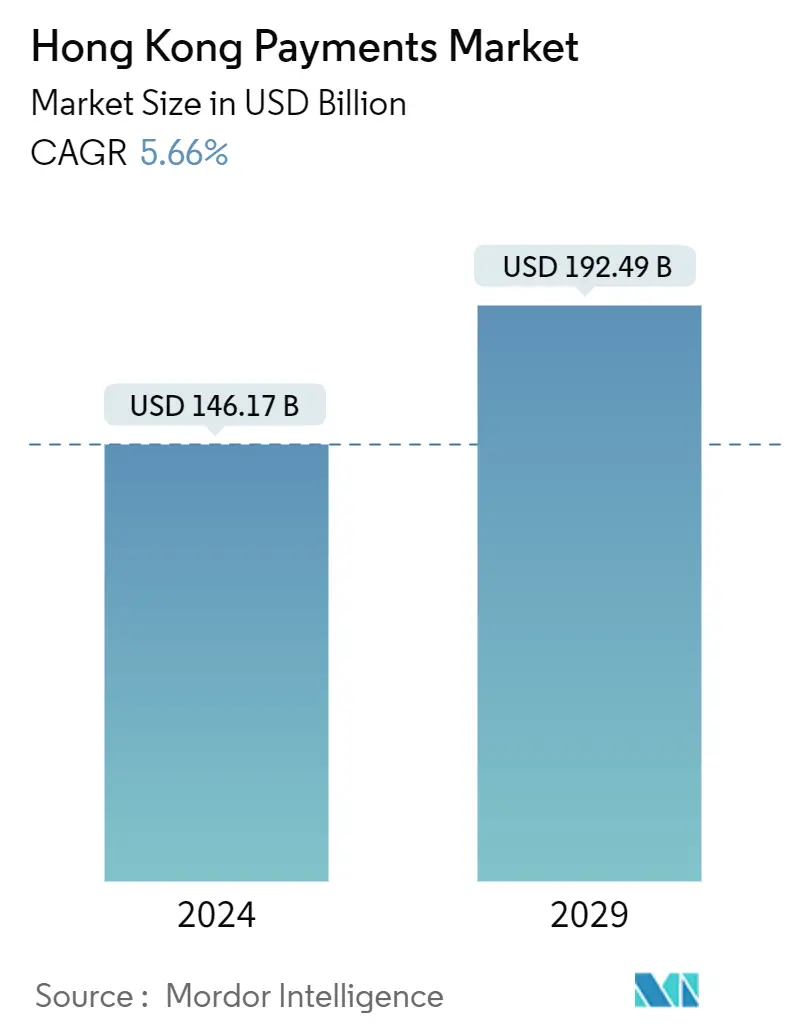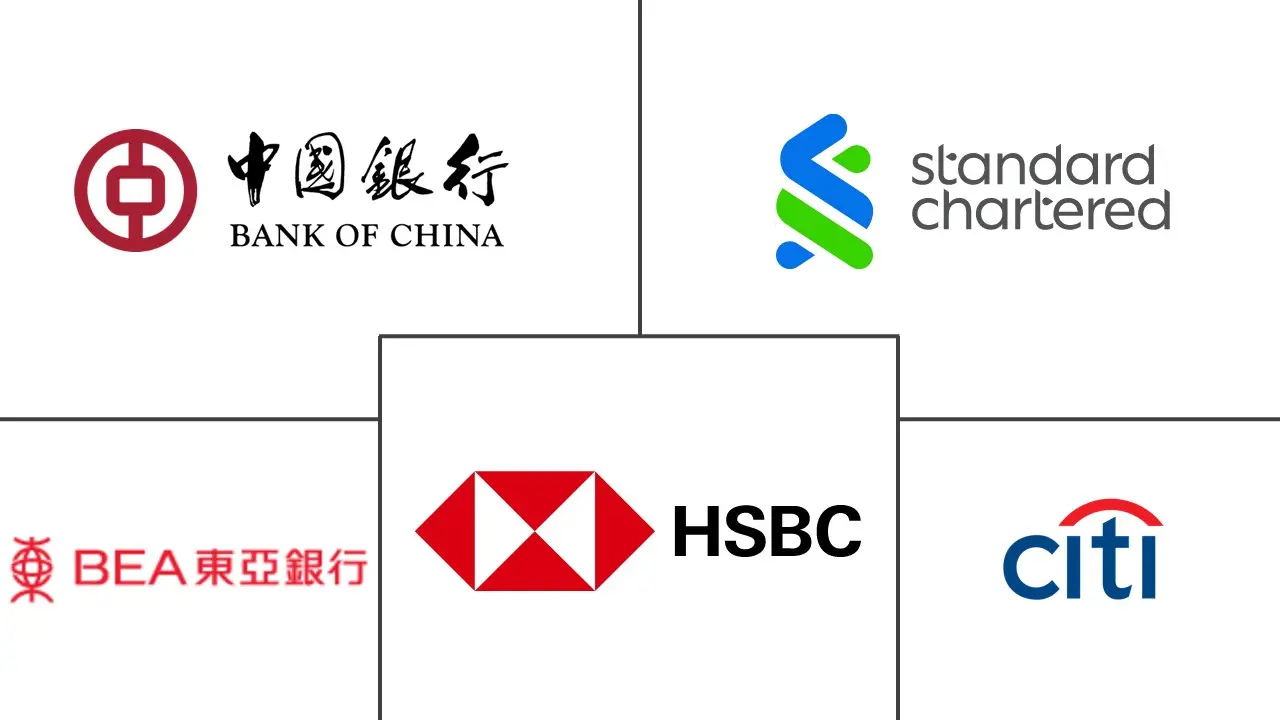Market Size of Hong Kong Payments Industry

| Study Period | 2019 - 2029 |
| Base Year For Estimation | 2023 |
| Market Size (2024) | USD 146.17 Billion |
| Market Size (2029) | USD 192.49 Billion |
| CAGR (2024 - 2029) | 5.66 % |
| Market Concentration | Low |
Major Players
*Disclaimer: Major Players sorted in no particular order |
Hong Kong Payment Market Analysis
The Hong Kong Payments Market size is estimated at USD 146.17 billion in 2024, and is expected to reach USD 192.49 billion by 2029, growing at a CAGR of 5.66% during the forecast period (2024-2029).
Cashless transactions are becoming more common, and the industry's responsibility to promote inclusion has risen to the top of its priority list. Payments provide a strong foundation for commerce and foster the growth of digital economies. Due to the growth of smartphones, expanding businesses, and customer preference for digital transformation, the landscape of transactions and payments is evolving fast.
- As Hong Kong tries to modernize its economy and get more people involved in digital banking, strong government backing usually supports the trend toward real-time payments. The real-time faster payments service (FPS) in Hong Kong has seen an almost tripling in both the volume and value of transactions, which is expected to drive the regional payments market.
- Hong Kong is a prosperous, heavily financed region with first-rate physical and digital infrastructure. The region is transitioning from cash transactions to the digital era, and the current payments landscape has been very interesting to observe. EWallets, mobile payments, virtual banking, and the potential use of cryptocurrencies in the future are replacing traditional cashless payment methods like credit and debit cards.
- In recent years, the HKMA has implemented many initiatives to promote the growth of the electronic payment market in Hong Kong. The Common Quick Response (QR) Code Specification for retail payments in Hong Kong, as well as the Hong Kong Common QR Code mobile application, enable businesses to combine multiple QR codes from various payment service providers into a single, combined QR code and display it at the point of sale or print it on bills to accept payments from a variety of different payment methods like in Hong Kong Dollar (HKD) or Renminbi (RMB).
- There is no specific legislation on payment systems in Hong Kong. However, several laws directly affect various payment instruments and institutions. The Personal Data (Privacy) Ordinance (Cap. 486) (PDPO) is in charge of being implemented in Hong Kong, and it is the responsibility of the Privacy Commissioner for Personal Data (PCPD) to ensure compliance.
- Data transfer is an essential thing in the Digital Payment scenario. While the PCPD works to protect personal data in Hong Kong, it also understands the necessity to exercise its authority within a specific framework to avoid stifling the free flow of information, which is considered essential to a data-driven economy. PDPO has not yet begun operations, even though the legislation was passed in 1995. However, continuous efforts and changes can be seen in this direction to improve cross-border transactions.
- In recent years, Hong Kong's e-commerce market has grown significantly. The region has a high level of internet penetration due to recent technological advancements. More customers are adopting mobile devices to make online purchases of products and services due to the COVID-19 pandemic. Post-pandemic, with the rising usage of e-wallets, e-commerce, BNPL, and other digital financial services, Fintech businesses, banks, and payment providers have gained direct access to client purchasing patterns and demographics. These factors are analyzed to provide significant opportunities to the players in the country, thereby boosting the market growth rate.
Hong Kong Payment Industry Segmentation
The point of sale is the time and location where a transaction is completed. A point-of-sale (POS) system is a combination of computer hardware and software that manages transactions during the sale of a product or service. It helps to store, capture, share, and report data related to sales transactions. It eases the shopping experience and helps expedite the checkout process, resulting in customer satisfaction. Inventory management, stock in hand, availability of a product, and pricing information are the primary data acquired from the systems.
The Hong Kong Payment Market is segmented by mode of payment (point of sale (card payments, digital wallet, cash), online sale (card payments, digital wallet)) by end-user industry (retail, entertainment, healthcare, hospitality). The market sizes and forecasts are provided in terms of value in USD for all the above segments.
| By Mode of Payment | ||||||
| ||||||
|
| By End-user Industry | |
| Retail | |
| Entertainment | |
| Healthcare | |
| Hospitality | |
| Other End-user Industries |
Hong Kong Payments Market Size Summary
The Hong Kong payments market is undergoing a significant transformation, driven by the increasing adoption of cashless transactions and digital payment solutions. The region is experiencing a shift from traditional cash-based methods to digital platforms, including e-wallets, mobile payments, and virtual banking. This transition is supported by robust government initiatives and advancements in digital infrastructure, which aim to enhance financial inclusion and promote a cashless economy. The introduction of real-time payment services, such as the Faster Payments Service (FPS), has significantly increased transaction volumes and values, further propelling the market's growth. The Hong Kong Monetary Authority (HKMA) has been proactive in implementing measures to foster the electronic payment landscape, including the Common QR Code Specification, which streamlines payment processes for businesses.
The competitive landscape of the Hong Kong payments market is characterized by the presence of major financial institutions and fintech companies that are actively pursuing strategic partnerships and technological innovations. Key players such as HSBC, Bank of China, and Standard Chartered Bank are expanding their services to include cross-border payment solutions and digital currency initiatives. The market is also witnessing a rise in the use of payment cards, supported by favorable policies and an expanding point-of-sale infrastructure. As e-commerce continues to grow, driven by high internet penetration and changing consumer behaviors, businesses are increasingly adopting digital payment options to enhance customer experience and drive sales. The ongoing developments in the market, including the exploration of Central Bank Digital Currencies (CBDCs) and the integration of cryptocurrencies, indicate a dynamic and evolving payment ecosystem in Hong Kong.
Hong Kong Payments Market Size - Table of Contents
-
1. MARKET INSIGHTS
-
1.1 Market Overview
-
1.2 Industry Stakeholder Analysis
-
1.3 Industry Attractiveness - Porter's Five Forces Analysis
-
1.3.1 Bargaining Power of Suppliers
-
1.3.2 Bargaining Power of Buyers
-
1.3.3 Threat of New Entrants
-
1.3.4 Threat of Substitutes
-
1.3.5 Intensity of Competitive Rivalry
-
-
1.4 Evolution of the Payments Landscape in the Country
-
1.5 Key Market Trends Pertaining to the Growth of Cashless Transactions in the Country
-
1.6 Impact of COVID-19 on the Payments Market in the Country
-
-
2. MARKET SEGMENTATION
-
2.1 By Mode of Payment
-
2.1.1 By Point of Sale
-
2.1.1.1 Card Payments
-
2.1.1.2 Digital Wallet
-
2.1.1.3 Cash
-
2.1.1.4 Other Point of Sales
-
-
2.1.2 By Online Sale
-
2.1.2.1 Card Payments
-
2.1.2.2 Digital Wallet
-
2.1.2.3 Other Online Sales
-
-
-
2.2 By End-user Industry
-
2.2.1 Retail
-
2.2.2 Entertainment
-
2.2.3 Healthcare
-
2.2.4 Hospitality
-
2.2.5 Other End-user Industries
-
-
Hong Kong Payments Market Size FAQs
How big is the Hong Kong Payments Market?
The Hong Kong Payments Market size is expected to reach USD 146.17 billion in 2024 and grow at a CAGR of 5.66% to reach USD 192.49 billion by 2029.
What is the current Hong Kong Payments Market size?
In 2024, the Hong Kong Payments Market size is expected to reach USD 146.17 billion.

